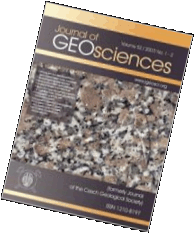 Export to Mendeley
Export to MendeleyOriginal Paper (in print)
Cymrite, celsian and associating Ba-rich minerals in metacarbonates from the Čučma - Čierna baňa manganese deposit (Slovakia, Western Carpathians)
DOI: http://doi.org/10.3190/jgeosci.0032.25
The Čučma - Čierna baňa manganese deposit (Slovakia, Western Carpathians) hosts barium-rich mineralisation within the Early Paleozoic metacarbonate lenses associated with graphite-, quartz-muscovite phyllites and metalydites. The main metacarbonate mineral is represented by calcite containing up to 94.2 mol. % CaCO3, with minor amounts of Mn, Fe and Mg constituents. The Ba-mineralisation consists of silicates such as cymrite, celsian, Ba-rich muscovite and baryte along with clinochlore, quartz, spessartine and accessory fluorapatite and rutile. Cymrite forms prismatic to tabular aggregates, commonly associated with celsian and Ba-rich muscovite, it displays a stable chemical composition close to the theoretical end-member formula. Celsian (89.0-97.3 mol. % Cls) with minor Na, K, Ca, and Sr contents typically occurs as anhedral grains and is overgrown by cymrite, indicating a possible hydration transformation. Ba-rich muscovite shows complex chemical zoning, suggesting variable Ba incorporation through multiple substitutions predominantly in Ba-enriched zones (up to 0.32 apfu Ba). Clinochlore lacks any Ba and is interpreted as a retrograde phase. Textural, chemical and structural evidence studied by optical microscopy, electron microprobe analyses (EPMA) and Raman spectroscopy indicates a multi-stage development involving baryte or barium enrichment during sedimentation influenced by submarine basic volcanism, subsequently followed by Variscan and Alpine metamorphic events. Metamorphic recrystallisation mobilised Ba, leading to the formation of Ba-rich silicates. The Ba-rich mineral assemblage and associated textures reflect the complex metamorphic evolution of the deposit and highlight cymrite and celsian as a key indicator of low-grade metamorphism in the studied Ba-rich environment. The presence of spessartine (up to 60.0 mol. % Sps) and other accessory phases further illustrates a close relation with associated manganese mineralisation.
Webdesign inspired by aTeo. Hosted at the server of the Institute of Petrology and Structural Geology, Charles University, Prague.
ISSN: 1803-1943 (online), 1802-6222 (print)
email: jgeosci(at)jgeosci.org


IF (WoS, 2024): 1.3
5 YEAR IF (WoS, 2024): 1.4
Policy: Open Access
ISSN: 1802-6222
E-ISSN: 1803-1943